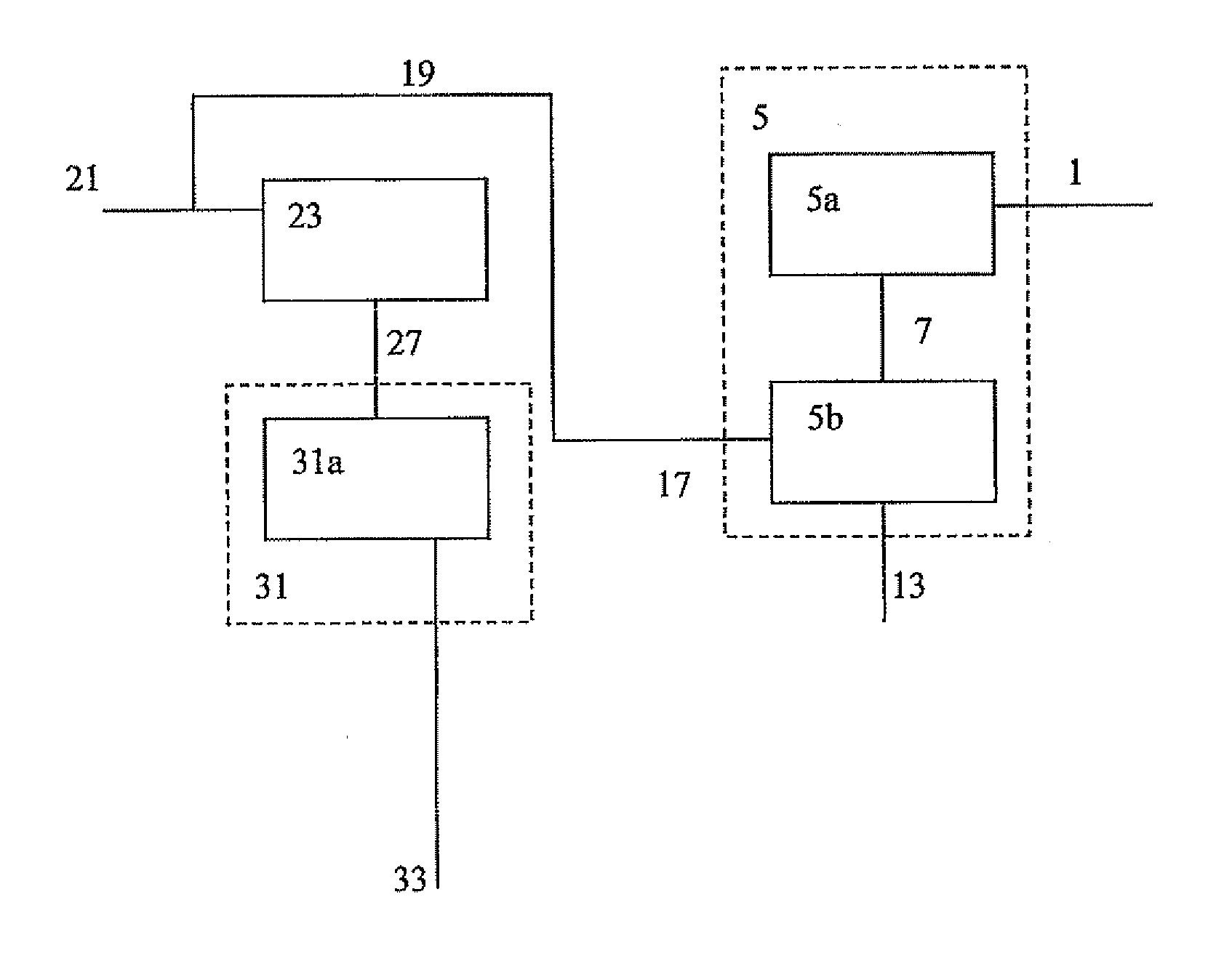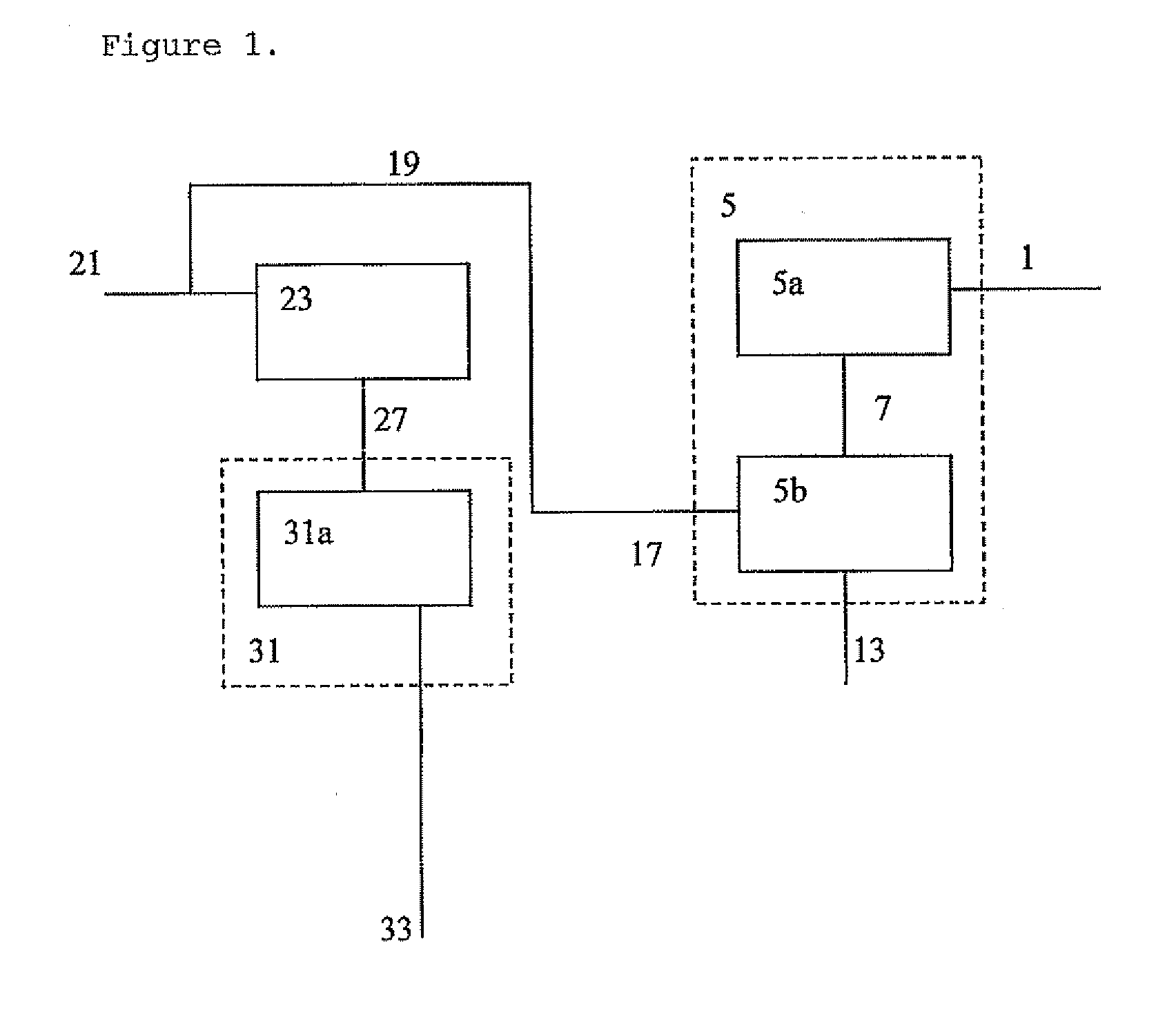Process for producing aromatic hydrocarbons and ethylene
- Summary
- Abstract
- Description
- Claims
- Application Information
AI Technical Summary
Benefits of technology
Problems solved by technology
Method used
Image
Examples
example 1
[0177]In the Examples, several options of implementing the present invention are compared with comparative examples, by means of model calculations. As basis for Examples 1a to g, a model integrated OTO / ATA process was taken. In Table 1, an overview is provided of the feed input and the calculated products.
[0178]Calculations were done using proprietary models for modelling the OTO and ATA conversion. The key input to the models was as follows:
ATA Conversion:
[0179]A feed containing 31.6 wt % ethane, 29.5 wt % propane and 38.9 wt % butane is converted to at least benzene, toluene and xylenes, using a two stage reactor system. 3300 t / d of mixed feed are fed to a first stage aromatization reactor that uses a catalyst for aromatizing these lower alkanes. The first stage reactor operates at about 1 atmosphere pressure and at a temperature of about 600° C.
[0180]The first stage reactor effluent is then mixed with the reactor effluent from the second stage reactor described below. The combin...
experiment 1a
g to the invention)
[0196]The methanol feed to the OTO process is synthesised from a mixture of SGP and SMR synthesis gas. 2949 ton / day of natural gas is required produce sufficient methanol. Experiment 1b:
[0197]The methanol feed to the OTO process is synthesised from a mixture of part of the hydrogen ex. ATA and SGP synthesis gas. By providing hydrogen ex. ATA to the methanol synthesis, the natural gas consumption for producing the methanol has decreased by 8 wt % based on the natural gas required for producing the methanol in Experiment 1a. There is no longer the need to add additional SMR synthesis gas. Moreover, by not using a SMR synthesis gas the water consumption decreases significantly, in principle no water is used for the synthesis gas production.
[0198]Furthermore, inert (N2, Ar and CH4) concentration in the feed to the methanol synthesis are reduced, compared to the levels seen in experiment 1a, due to dilution of the SGP synthesis gas with hydrogen obtained from the ATA p...
experiment 1c
[0199]The methanol feed to the OTO process is synthesised from a mixture of part of the hydrogen ex. ATA and SGP synthesis gas. In addition, pure carbon dioxide ex. field is added to increase the carbon dioxide content to 3.3 mol %, based on the total feed to the methanol synthesis. The natural gas consumption for producing the methanol has decreased by 12 wt % based on the natural gas required for producing the methanol in Experiment 1a. In addition, 255 ton / day of methanol is produced based on waste carbon dioxide, i.e. carbon dioxide not produced as part of the process to prepare synthesis gas, which would need to be sequestered or otherwise captured and stored. As a result, the carbon dioxide penalty of the process is reduced.
[0200]Again, inert (N2, Ar and CH4) concentrations are further lowered.
PUM
| Property | Measurement | Unit |
|---|---|---|
| Molar density | aaaaa | aaaaa |
| Molar density | aaaaa | aaaaa |
| Molar density | aaaaa | aaaaa |
Abstract
Description
Claims
Application Information
 Login to View More
Login to View More - R&D
- Intellectual Property
- Life Sciences
- Materials
- Tech Scout
- Unparalleled Data Quality
- Higher Quality Content
- 60% Fewer Hallucinations
Browse by: Latest US Patents, China's latest patents, Technical Efficacy Thesaurus, Application Domain, Technology Topic, Popular Technical Reports.
© 2025 PatSnap. All rights reserved.Legal|Privacy policy|Modern Slavery Act Transparency Statement|Sitemap|About US| Contact US: help@patsnap.com



